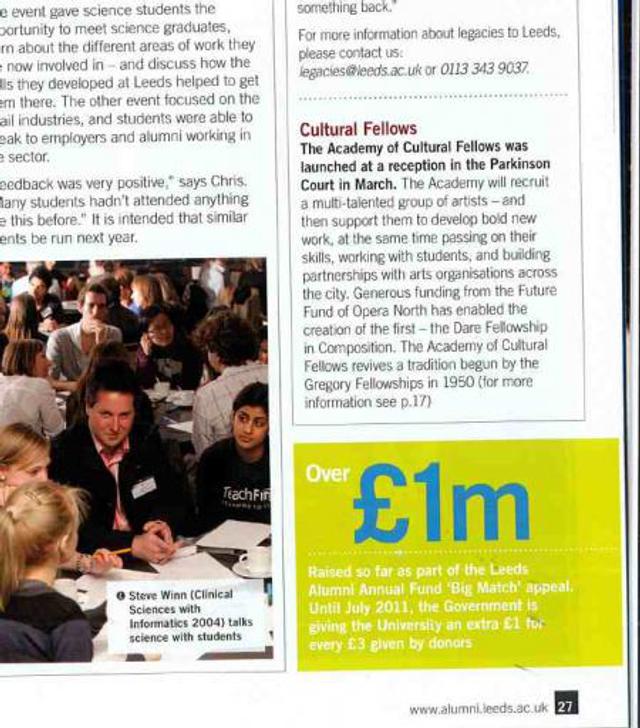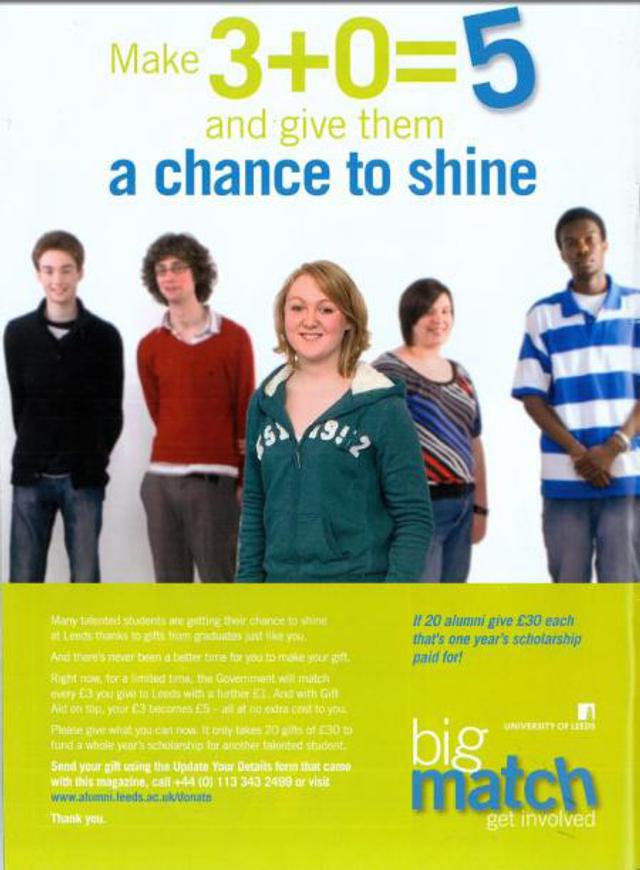University fundraising: how to reach younger alumni cost effectively
- Exhibited by
- Adrian Salmon
- Added
- May 05, 2011
- Medium of Communication
- Press Advertising.
- Target Audience
- Individuals.
- Type of Charity
- Education.
- Country of Origin
- UK.
- Date of first appearance
- October, 2009.
SOFII’s view
Alumni fundraising can be notoriously difficult to deliver. Keeping track of recently departed students who move from one place to another in the early bloom of their careers and keeping the more established alumni members engaged with a rapidly fading memory of their student days is a significant challenge to surmount. Here, the University of Leeds have really put some thought into the best way to overcome these problems, managing not only to cut the cost of their campaigns but to reach more members and, most importantly, to increase levels of giving. Thank you to the University of Leeds for sharing their results and giving us an insight into an area of fundraising that we rarely get an opportunity to see.
University of Leeds Alumni and Development Team, THINK Consulting Solutions.
To deliver a fundraising message as cost-effectively as possible to the University’s entire alumni population.
Background
Increasingly, UK universities are trying to ask all their alumni at least once a year for financial support.
The telephone tends to be a university’s most cost-effective tool for donor acquisition, but universities do not typically have viable telephone numbers for all their alumni.
Some universities can offset this difficulty efficiently with direct mail appeals to all alumni, but in the University of Leeds’ case, nearly two-thirds of its alumni base is under 40 years old. This demographic meant that direct mail campaigns to the entire alumni base had extremely low response rates, an acquisition cost of over £200 per donor and very poor return on investment.
However, the University also sends an alumni magazine, Leeds, to its entire alumni base worldwide, twice a year. The alumni and development team decided to test whether a full-page advert on the back of the magazine, supported by donation options in the ‘update your details’ form enclosed with the magazine, could generate comparable returns to a ‘stand-alone’ direct mail appeal. This meant it was at a much lower cost, as all the print and postage for the magazine was covered anyway.
Results
See the attached images for the adverts themselves and their individual results. The first year’s two advertisements, in autumn 2009 and summer 2010, generated just over £18,000 from 306 alumni donors.
This was 57 per cent more income than the previous year’s stand-alone direct mail appeal, at only 16 per cent of the cost. The acquisition cost per donor was £22, compared to over £200 for previous stand-alone direct mail appeals.
If the development team had had to pay commercial rates for these advertisements, a full page ad on the back page of Leeds magazine would probably be charged out at between £3,000 and £5,000. This would have meant that the ads generated a return on investment of between 1.08:1 and 1.42:1; the acquisition cost would have gone up to between £40 and £55 per donor. Even this would have been better than breaking even and they didn’t have to pay for the ads.
Naturally this is a small proportion of fundraised income compared to that generated by the telephone, but it does begin to provide a viable ‘non-phone’ option for this university for donor acquisition.
Merits
UK universities are still in a process of discovering which messages will be most effective in promoting giving from their alumni, and which methods will deliver these messages as cost-effectively as possible to as many of their alumni as possible. I hope these encouraging results will be useful to other institutions seeking to test fundraising approaches in the same way.
Follow up of the project:
UPDATE from Adrian Salmon - Annual Fund Manager - Alumni & Development Team, University of Leads: 20 Jul. 11
I thought I'd just post an update on the results from our ads. As of today, 20 July 2011, our total income from the magazine adverts this year has been just shy of £30,000 - just over 60% up on last year. We're delighted, it looks like 'effective frequency' and our highlighting of the July 2011 deadline in our ads this year has really worked for us. Magazine response now accounts for 62% of our mail generated income for this year.
 View original image
View original image
 View original image
View original image
 View original image
View original image
 View original image
View original image
 View original image
View original image
















